
INDIE AUDIO
Bryce Roberts
All episodes
Best episodes
Top 10 INDIE AUDIO Episodes
Goodpods has curated a list of the 10 best INDIE AUDIO episodes, ranked by the number of listens and likes each episode have garnered from our listeners. If you are listening to INDIE AUDIO for the first time, there's no better place to start than with one of these standout episodes. If you are a fan of the show, vote for your favorite INDIE AUDIO episode by adding your comments to the episode page.
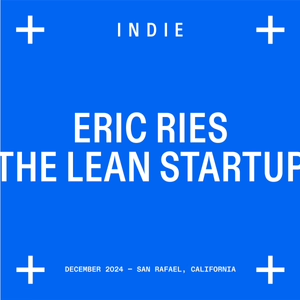
02/07/25 • 88 min
Late last year, we sat down with Eric Ries, who fundamentally changed how we think about building startups through The Lean Startup. Only Eric can make corporate governance sound poetic. The conversation took an unexpected turn as we delved into what Ries calls "vampire founders" - leaders who feel immortal yet isolated, watching employees come and go while they remain eternally at the helm. This phenomenon stems from founders conflating their identity with their companies, leading to a uniquely lonely experience that differs markedly from traditional CEO roles.
The discussion revealed how the current startup ecosystem, flush with capital but short on genuine opportunities, has created a pressure cooker environment where founders often compromise their original values to fit institutional expectations. Ries argues that most entrepreneurs start with genuine idealism but get caught in a system that strips companies of their distinctiveness - what he calls being "surgically deboned". This process happens gradually through what Ries terms "gravity," where financial transactions unconsciously transmit values that pull companies toward conformity.
Perhaps most provocatively, Ries challenges the fundamental premise of shareholder primacy theory and suggests that the way we currently build companies is neither inevitable nor optimal. He points to examples like Anthropic's Long Term Benefit Trust as evidence that alternative governance structures can work, while arguing that the current system's defenders spend inordinate energy convincing everyone that the status quo is inevitable - a sure sign, he suggests, that it isn't.
Some key insights from this video:
The "vampire founder" phenomenon describes leaders who feel immortal yet isolated, watching teams cycle through while they remain unchanged
Most founders begin idealistic but face systemic pressure to conform, leading to companies losing their distinctiveness over time
The startup ecosystem has more capital than good opportunities, creating pressure to grow at unnatural rates
Traditional governance structures often force unnecessary compromises that make both founders and companies weaker
Alternative governance models exist and can work, but the system actively resists their adoption becoming widespread
Financial transactions always transmit values unconsciously, creating a gravitational pull toward conformity
The current startup system is defended not because it's inevitable, but because it's actually quite fragile
Most founders who achieve financial success still end up deeply unhappy due to the compromises they made along the way
Building trustworthy companies is actually more profitable than exploitation, but the system makes this hard to see
Change is possible - Ries points to how The Lean Startup went from radical idea to conventional wisdom in just a few years.

Terminal NYC with Reggie James
INDIE AUDIO
01/23/25 • 63 min
On my flight to NYC last week, I casually asked if there were any events happening in the city while I was there.
Reggie, who you may remember from his New Hardware video, and as the person who coined the term “indie-pilled”, replied that we should do one of our own.
So we did.
Thankfully we had our cameras in tow and were able to record the conversation. It turned into a nearly 2hr Q&A on all things indie, the current state of venture, the evolution of seed, the role of secondaries in venture, and some funny untold indie lore.
In the video, Reggie mentions a piece he recently wrote titled “Lies My Teacher Told Me”, which set some timely context for this event.
From the essay:
"The point of this is short. The new thing has to look like the new thing, which makes it hard to pattern match to the previous new thing. But pattern matching is at the heart of de-risking. This creates a weird loop of advice.
The previous advice of zero interest rates and Snapchat as the last big thing for consumer software was to grow at all costs / monetize later / find novel behavior.
Nikita Bier showed all of this was wrong with Gas App. Monetize directly in the V1. De-risk through known behavior. Growth inputs must be advantageously proportional to the monetization in the V1.
There wouldn’t be a single VC that could share this advice. As a result, we’ve only had 1 US consumer internet win since Snapchat."
My sense is that that’s why indie is resonating so strongly this time around. As we wrote in our FACTS section:
"The game has changed. ZIRP-era playbooks of VC treadmills, pump and dump schemes, and growth at all costs have aged like milk. The future belongs to real builders, building real businesses.
There’s a time-tested playbook for building generational companies — less time fundraising, more time building, with a focus on the fundamentals. Most of the iconic companies of the past, think Amazon, Microsoft, and Google as well as emerging leaders like Midjourney, Vanta, and Zapier, have followed a similar playbook.
We’ve built our firm from the ground up with this playbook in mind."
This is the future we’re been building towards, and it seems to be hitting an inflection point.
Thanks to Reggie and the team at Earshot for hosting us and making this happen on short notice.
Hope you enjoy listening as much as we enjoyed having this conversation.
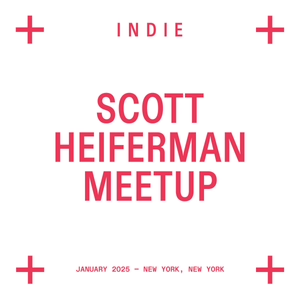
02/21/25 • 57 min
It is incredibly rare to have your startup become a verb. Google and Uber immediately come to mind. But what about when a group of strangers or friends with shared interests decide they want to get together? They, Meetup.
Scott Heifferman didn’t set out with becoming a verb in mind but he certainly started Meetup with the intent of building something big and impactful. And on those dimensions he delivered in spades. Along the way he sold 30% of his company for $1M to Tim Draper’s DFJ (funny story around the 36 min mark), raised from other great investors (Brad Burnham from USV makes a cameo in the video), met face to face with Mark Zuckerberg who also decided that getting groups of people to meetup would be important for Facebook too, going so far as to run their very first Super Bowl ad promoting their meetup competitor product. There are so many great stories and anecdotes in this one.
In our effort to mine Web 2.0 ideas and playbooks for applicable lessons for this current wave to startups, this conversation delivers in spades. A few take aways:
— The Origins of Meetup and Community Building: Heiferman reflects on how 9/11 and experiences like Burning Man inspired Meetup’s mission to foster real-world connections. He emphasized the importance of creating tools that empower people to form communities and build belonging offline, using the internet as a catalyst.
— Early NYC Tech Scene vs. Silicon Valley: Heiferman shares stories of the scrappy, experimental nature of the 1990s NYC tech ecosystem, contrasting it with Silicon Valley’s more established infrastructure. He recalls starting iTraffic with maxed-out credit cards and seeing startups like Razorfish and DoubleClick shape the local scene.
— Facebook’s Competitive Threat: Heiferman recounts how Facebook’s groups feature directly competed with Meetup, even running Super Bowl ads mimicking its concept. This competition influenced his decision to sell Meetup to WeWork, as Facebook’s scale and resources were hard to match.
— Critique of Modern Marketplaces: Heiferman critiques platforms like Uber and DoorDash for extracting excessive margins from workers and businesses. He advocates for a fairer market economy where technology empowers individuals rather than exploiting them.
— Future Vision and Lessons Learned: Looking ahead, Heiferman expresses interest in building impactful projects outside traditional VC structures. He emphasizes the need to focus on creating products that energize people, deliver value, and prioritize meaningful societal impact over maximizing profits.
One thing that especially stood out to me in this conversation was a reminder of how “people” were so core to Web 2.0 ideals. Whether it was getting people to connect online or off, fostering real and personal connection was such an important driver for innovation at that time. When today’s headlines are so filled with stories that seem to pit people against algorithms, Scott’s sentiment is a refreshing reminder that technology at it’s best is a tool for enhancing our lives, not eradicating them.
On that theme, a comment Scott made has been rattling in my head ever since. At around the 40 min mark he says something along the lines of “AB testing is the price you pay for not having a pulse on people”. In this conversation he talk a lot about energy, following the energy of individuals and his own energy and interests. He seems energized to build again and we talk a bit about what’s next for him and how his time working in an Amazon warehouse informed his thinking around what problems he wants to tackle. We can’t wait to see where he goes with all that energy.
This was a ton of fun to connect with Scott and Brad to revisit the Meetup story. We hope you enjoy listening as much as we enjoyed recording it.

Startup Confessionals Vol. 1 — Ben Kaufman (Camp), Harper Reed (Galactic), Finbarr Taylor (Shogun)
INDIE AUDIO
11/15/24 • 18 min
A few weeks back in this very email, I put out a request for a new content format we wanted to experiment with that we called “Startup Confessionals”.
From my note:
If you, or founders you know, are willing to share a startup confessional, we’d love to help. We can make these totally anonymized or public, whatever you're comfortable with. We'll be recording these remotely and aren't looking for hours long conversations — we're planning on editing them into quick lessons and anecdotes.
For example, here are “confessional” conversations I’ve had with people one-on-one just in the last few weeks:
— Over/under raising
— Surprising/shocking fundraising stories
— Horror stories of investors/board members behaving badly
— Hiring to please investors
— Acquisitions blocked or held hostage by investors/board members
Thankfully, a few heeded the call. I think this week’s video captures the essence of what we were going for and the experiences we were hoping to mine.
This week, we have stories and lessons from some legendary founders —
Ben Kauffman
Founder of Quirky and Camp as well as CMO at Buzzfeed. Ben has an incredible knack for building brands and storytelling that has attracted some of the largest brand partnerships and most legendary investors.
Harper Reed
Came into the national spotlight as the Chieff Technology Officer for Barack Obama’s re-election campaign. Shortly after, with encouragement and funding from then-Google CEO Eric Schmidt, he founder Modest which was later acquired by PayPal. Most recently, he wound down a venture backed startup Galactic. He’s currently exploring new ideas with his longtime collaborators.
Finbarr Taylor
Got his start in tech in various staff roles at companies like Groupon, Pebble, and Y Combinator. As a co-founder of Shogun, he and his partners bootstrapped to over $1M in ARR before raising their first round of funding. That first round let to another and then another. Shogun continues to be a thriving business that Finbarr remains on the board of and actively advises in addition to angel investing. His takeaways from bootstrapping to rocketship growth to near unicorn status are lessons not to be missed or dismissed.
This is our first attempt at this format and we’re so grateful to Ben, Harper, and Finbarr (as well as the others we have in the can) for being willing to wade into such uncertain waters with us.
We’re really happy with how this turned out and welcome your feedback on how we can improve it over time.
We’d also welcome more stories from you or your networks. If you know someone who’d be fun/interesting/insightful on the topic of unpacking their founder, or early employee experiences and lessons, please send them our way!
As always, we hope you enjoy watching this one as much as we all enjoyed making it.
Bryce

12/13/24 • 60 min
There’s a section of our website that generates more reaction than any single piece of content I’ve ever written. It says:
We’re obsessed with the idea that someone is going to build a business doing $100M in revenue with less than 10 employees and see it as this generation of founders’ 4 min mile. Once someone shows it can be done, many more will follow. We want to partner with the one that does to help define a repeatable playbook for those that follow.
Whether the numbers are correct or simply guide posts, it’s undeniable that how and what we build in a post-AI world is changing by the day. (Maybe hour?) This theme has been a clear focus for our investing at indie and has shown up in the form of AI infrastructure, AI services, and new work modalities enabled by AI.
This week, we sit down with a founder at the vanguard of post-AI entrepreneurship — Rahul Sonwalkar of Julius AI. One thing I was struck by in this conversation is not only the efficiency and speed that new AI tools unlock, but the ability to embed more of the humanity of the founders into the businesses they are building as both a competitive moat and differentiator. Rahul is the embodiment of this in ways that will become clear in the video.
The story of Julius begins after six pivots and countless experiments. Rahul and his team built Julius.AI by embracing a hacker mentality and following their instincts rather than conventional startup wisdom. Instead of building a massive sales organization or chasing traditional metrics, they focused on product-led growth and let users discover the value naturally. Today, Julius processes over two million lines of AI-generated code daily, helping knowledge workers analyze data without needing to code or relying on data analysts for their insights.
The funding landscape has shifted dramatically with AI-native startups. These companies can operate much more efficiently than their predecessors, giving them more optionality around fundraising. Rather than raising capital at predetermined milestones, Rahul has taken a more opportunistic approach, something we call “macrodosing capital”, raising smaller amounts when offered and focusing on infrastructure investments that will pay dividends long-term.
Looking ahead, Rahul believes the key to building in the AI-era is positioning your company to benefit from, not be threatened by, improving technology. While giants like ChatGPT attempt to replicate features, Julius has found that the large player’s marketing efforts actually educates the market and drives users to more specialized solutions. Rahul aims to go public eventually, seeing a massive opportunity in making AI-powered products accessible to everyone — not just developers.
This is a must watch for anyone curious about how AI is reshaping entrepreneurship and the opportunities it presents.
That said, if you’re looking for actionable insights or a playbook here, you may find yourself frustrated. This is an emerging field where the landscape is shifting underneath us. Any tools or tactics mentioned here could be obsolete by the time you finish watching. The core ideas of being true to your instincts, staying lean, doing more with less, and delivering value for customer feel even more timeless in the context of this conversation.
I hope you enjoy watching as much as we enjoyed making it. And if you do, please share widely. Like and subscribe. All that jazz.
And, as always, if you're working on anything in these areas that could be a fit for an investment from indie, don’t hesitate to reach out.
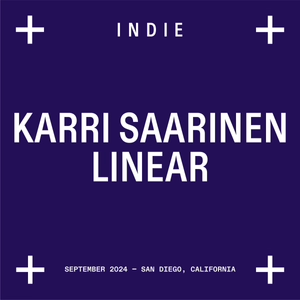
09/13/24 • 77 min
A few years back, I got a DM from a founder wanting to meet and swap stories about adventures in entrepreneurship. Despite being backed by some of the top VCs in the world, they were taking a very different approach from the classic VC blitzscaling playbook. As we sat on the back patio of a bar in Brooklyn, it was clear that how Jori and his founding team at Linear were building was very aligned with how we were encouraging founders to consider building through indie (note - we are, sadly, not investors in Linear).
Years and a Series B later, the Linear founders have continued building their company on their terms.
A few weeks back, I had the opportunity to sit down with Jori’s co-founder, Karri Saarinen, at his home in California for a wide-ranging talk. We covered everything from their time at some of the biggest hyperscalers of the last wave (think AirBnB, Coinbase, Uber), to net-negative lifetime burn rate (they’ve basically never spent the $52M they’ve raised), to their version of “Founder Mode”, to Finnish potato farming.
A few notable takeaways from this conversation:
Building a Different Kind of Company
Linear aims to build a company and product in a way that differs from typical Silicon Valley startups by focusing on product quality and craft rather than rapid scaling. By maintaining profitability and controlled growth instead of burning through venture capital, they’ve been able to build a venture-scale company without giving up optionality. The founders draw on their experiences at companies like Airbnb and Coinbase to avoid pitfalls they observed there, like culture dilution from hyper-growth. They’ve emphasized a small, high-quality team over rapid hiring.
Product and Growth Philosophy
Linear prioritizes product quality over growth hacks or aggressive marketing. By focusing on making the product so good that people naturally talk about it, they’ve been able to capitalize on word-of-mouth from satisfied users as a growth strategy.
Founder Approach
Karri emphasizes the importance of founders staying connected to the product and the craft. Because they care deeply about the output and quality of work, they can avoid creating unnecessary management layers or processes. Karri advocates for founders to think critically about standard startup advice and find their own path that aligns with their strengths and values.
Remote Work and Culture
Linear is fully remote, which they see as an advantage in maintaining focus and avoiding unnecessary distractions like office design. The company emphasizes clear communication and looks for employees with strong communication skills to thrive in a remote environment. Remote works if the founders want it to.
I really loved this conversation with Karri.
It highlights for me that there really is a new wave of ultra ambitious founders who are finding a way to stay true to themselves and their visions by focusing on what matters, and putting themselves in a position to controlling their own destiny. Linear, Vanta, Zapier, Webflow, and so many others are validating that growth at all costs doesn’t have to cost you everything.
I hope you enjoy listening to this conversation as much as we enjoyed recording it.
As always if you or someone you know are working on something that could be a fit for indie, don’t hesitate to reach out.

09/20/24 • 62 min
In April 2015, I read an article that elicited a reaction I’d only had a few other times prior.
We had just closed applications for our first round of experimental indie investments and had made most of our selections.
The article in question was titled Instagram’s TMZ, not exactly a title that would typically grab the attention of a Mormon dad in Utah. But I was captivated by the story and the mystery of the founder known only by her first name, Angie. By design, she was not the face of The Shade Room (TSR), that was a distinction for her large and growing audience of “Roommates” who kept the comments buzzing and the scoops flowing.
Any fan of pop culture knows that it's largely downstream of Black culture. Control the headwaters of culture, and you can shape the conversation around it. That’s the opportunity that I saw in TSR, but the risk was that they would follow the playbook of the other modern media giants of their generation - Buzzfeed and Vice. Unlike the latter, who had built their own technology and properties from the ground up, TSR leveraged existing social channels to go directly to their audiences. This was as practical as it was counterintuitive and ultimately led to a meaningful part of the TSR success story, while Buzzfeed and Vice have drifted into obscurity and irrelevance.
A few takeaways from this conversation:
The Shade Room's journey and growth:
Angie started The Shade Room in 2015 with a vision of it becoming influential and a cultural game-changer, despite having only a few thousand followers at the time. After indie's investment, Angie was able to take that confidence and has grown significantly since then. The Shade Room has become an integral part of Black culture and media, with a highly engaged community called "The Roommates".
Angie's approach to building The Shade Room:
Angie has purposefully kept the company bootstrapped, avoiding taking on additional investment in order to maintain ownership and control. She's turned down multiple 9-figure acquisition offers, driven by her long-term vision and purpose rather than financial gain. As a Black media company representing Black culture, The Shade Room faces increased scrutiny. Advertisers have undervalued The Shade Room's audience compared to other media outlets, like BuzzFeed and Vice. But because she kept her independence, the Shade Room was able to outlast those over-funded media companies.
Advice for those starting out:
If Angie was starting the Shade Room today, she'd follow these three pieces of advice —
1) Speak to yourself and your own interests.
2) Listen to your audience.
3) Truly know your audience.
Recording this conversation in Angie’s home was a beautiful contrast to when we first met. Her growth as a business builder and as a person has truly been highlight of my professional career. There’s no doubt in my mind that there’s much more runway ahead for her and TSR. Hopefully that can all happen without landing me in any more diss tracks...
We hope you enjoy listening as much as we enjoyed recording this one.
And as always, if you’re working on something that could be a fit for indie, or know someone who is, don’t hesitate to reach out.B
— Bryce
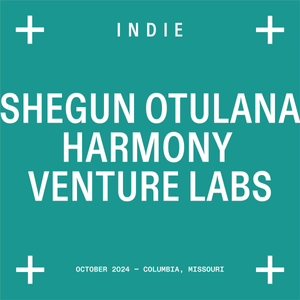
10/25/24 • 59 min
A few weeks back, I was the morning speaker at an event hosted by David Senra of FoundersPodcast (one of my favorite podcasts and people). The afternoon speaker was someone I’d never heard of before, Shegun Otulana. The story he told resonated deeply — a Nigerian immigrant who came to study at the University of Alabama. He had the drive to be an entrepreneur and had a few early attempts that ended in a failed partnership and a pile of debt.
Feeling like he was made for more than pushing pixels at a 9-to-5, and at the urging of his wife, Shegun set out to find a problem he could solve and eventually build a business around. A chance encounter led to meeting the head of a mental health clinic in Birmingham, AL. They needed a new system to run their practice but none seemed to fit their unique needs. After failing to find them something he could help them buy, Shegun built them a simple app. That simple app led to feature requests, which led to his first paying customer and then the word of mouth began to spread.
Within 5 years, after only having raised $250,000 from local angel investors and with no experience in the industry, that side project had become a thriving business doing north of $50M in ARR and was valued at hundreds of millions of dollars. Along the way, he has able to bring in PE investors and de-risk his personal finances with several rounds of secondary. He eventually sold the business to KKR in 2021 for $1.25B, making it the largest tech exit in Alabama.
Some takeaways from this one:
— Shegun built a successful healthcare software company through disciplined, customer-obsessed growth. Their approach centered on deeply understanding customer problems at counseling centers and building the initial product based on direct feedback. They found differentiation through an innovative pricing model aligned with customer needs and an SEO forward sales motion.
— Starting with just $250,000 in initial funding, Shegun grew the business to over $50M in revenue within 5 years, eventually selling to KKR for $1.25 billion. Shegun emphasized fundamental business principles rather than chasing fundraising hype. The company maintained strong financials with 30% profit margins and 90% gross margins, growing organically without requiring additional capital on the balance sheet.
— Shegun’s leadership philosophy focused on creating a culture of transparency where team members could be vulnerable while maintaining high standards. He built a distributed team to access talent cost-effectively and gave team members significant autonomy within clear guidelines.
At the conclusion of his talk at Senra's event, we both met in the hallway and gave each other a big hug. It was like finding someone who was a part of your tribe — speaking your same language and sharing your same values.
When we realized we’d both be at the Main Street Summit the following week, we decided then and there to get his story recorded. The MSS organizers were kind enough to turn over their main stage theatre for us to record in after hours and I think the resulting conversation and visuals make this one you can't skip.
I hope you enjoy listening as much as we enjoyed recording it.
As always, if you or someone you know is working on something that could be a fit for indie, don't hesitate to reach out.
Bryce
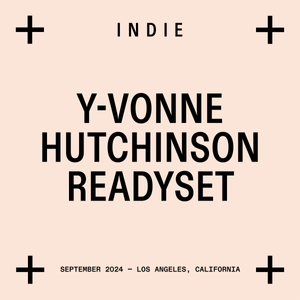
10/04/24 • 61 min
After wrapping this week’s conversation with published author and ReadySet’s CEO, Y-vonne Hutchinson, I stepped out of the studio, opened my phone, and X was ablaze.
In the year of our Lord 2024, a startup had decided that an anti-woke marketing campaign was the best possible way for them to generate attention for their payroll software company. The culmination of this campaign was one of their sales affiliates posting a racist rant. The fallout from this was all over my timeline. Even the most anti-woke of the tech set found themselves embarrassed and deeply uncomfortable with the direction and velocity the pendulum was swinging.
Tech has a tortured relationship with DEI, race, and gender. The world is becoming increasingly diverse, yet the number of employees and funded startup founders from diverse backgrounds has remain unchanged, if not shrunk. Because the Me Too, George Floyd, and Black Lives Matter movements have left a bad taste in the mouths of many tech leaders, I fear we’re at risk of throwing the baby out with the bath water.
At the heart of this uncomfortable conversation is something deeply important to company cultures specifically, and the future of tech broadly, so I invited my friend Y-vonne to talk about it.
Y-vonne and her company ReadySet were part of the Indie v4 batch of companies. I have a deep respect for her, her work, and the company she’s building. A few takeaways from this conversation:
Historical Context of DEI Efforts
Progress in diversity, equity and inclusion (DEI) often follows a pattern of advancement followed by backlash and retrenchment. This has happened repeatedly throughout U.S. history. The recent pushback against DEI initiatives can be seen as part of this historical pattern, rather than an isolated event. DEI efforts sometimes focused too much on individual change rather than systemic issues, leading to fatigue.
DEI in the Tech Industry
The broad, nebulous nature of “DEI” as a concept allowed it to become a target for criticism. Some DEI initiatives were performative rather than substantive, causing disillusionment. The tech industry initially embraced DEI efforts, but economic pressures and changing market conditions led many companies to cut DEI programs and staff. Some tech leaders have used DEI as a “boogeyman” to justify cuts, even though the underlying issues of bias and lack of diversity remain unaddressed.
DEI as a Business Imperative
Y-Vonne argues that DEI should be seen as a tool to solve real business problems like attrition, market share, and product-market fit. Companies that ignore diversity issues risk building products that don’t serve increasingly diverse markets and user bases. Companies should aim for “healthy culture” that enables collaboration and innovation, rather than trying to mandate diversity, but the healthiest cultures are diverse.
Moving Forward
Work environments should avoid causing trauma, but shouldn’t be expected to heal past traumas - that’s not their purpose. While companies shouldn’t be responsible for “healing” employees, leaders can adopt a more trauma-informed approach to avoid causing additional harm. Broader social and political change is needed to address systemic issues, beyond what individual companies can accomplish.
The world, and its demographics, are shifting so quickly it would be a huge miss for companies not to be thinking about how their culture can reflect the broader universe or potential customers and users.
This isn’t about quotas or raising or lowering bars, it’s about capturing opportunity.
This was such an engaging and energizing conversation for both Y-conne and I. We hope you enjoy listening as much as we enjoyed recording it.
Show more best episodes

Show more best episodes
FAQ
How many episodes does INDIE AUDIO have?
INDIE AUDIO currently has 36 episodes available.
What topics does INDIE AUDIO cover?
The podcast is about Entrepreneurship, Investing, Podcasts, Technology, Business and Fundraising.
What is the most popular episode on INDIE AUDIO?
The episode title 'Venture Capital Curmudgeons Club with Eric Paley of Founder Collective' is the most popular.
What is the average episode length on INDIE AUDIO?
The average episode length on INDIE AUDIO is 64 minutes.
How often are episodes of INDIE AUDIO released?
Episodes of INDIE AUDIO are typically released every 6 days, 23 hours.
When was the first episode of INDIE AUDIO?
The first episode of INDIE AUDIO was released on Jul 3, 2024.
Show more FAQ

Show more FAQ
